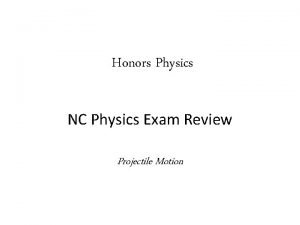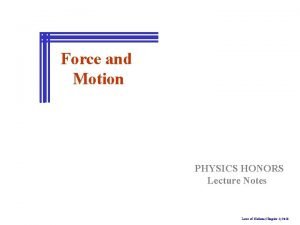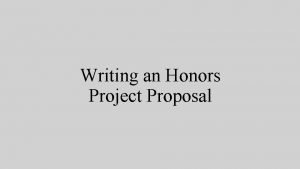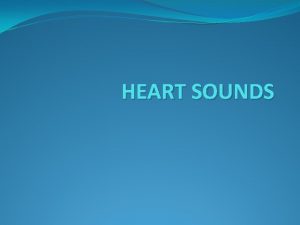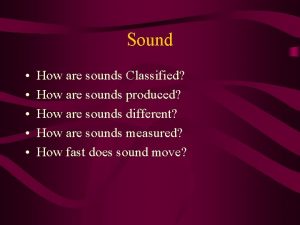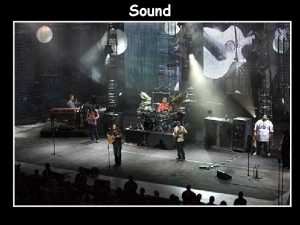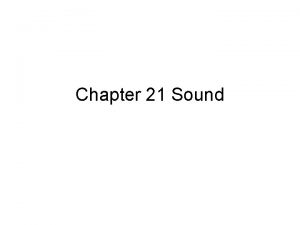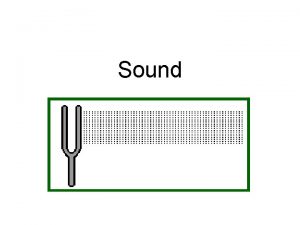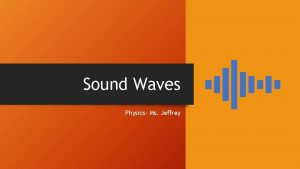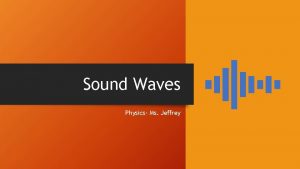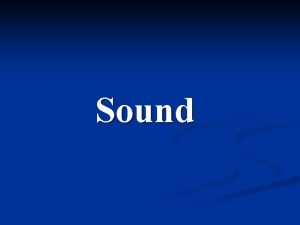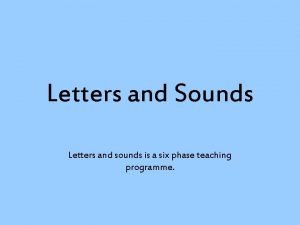Sound Physics Honors Sound Source All sounds are



















- Slides: 19

Sound Physics Honors

Sound Source • All sounds are produced by the vibrations of material objects • The frequency of sounds is often described by the word pitch. • The frequency range that humans can hear is limited: from about 20 to 20000 Hz – Below 20 Hz is called infrasonic – Above 20000 Hz is called ultrasonic

Loudness & Intensity • Loudness is subjective and is related to sound intensity • Loudness almost follows a log (10^x) pattern of intensity • Intensity is objective and can be measured (in d. B) or calc. • Intensity = P/(4Πr 2) • Units – W/m 2

Relative Intensity Source Intensity Decibels Threshold of Hearing (TOH) Rustling Leaves Whisper Normal Conversation Busy Street Traffic Vacuum Cleaner Large Orchestra Walkman at Maximum Level Front Rows of Rock Concert Threshold of Pain Military Jet Takeoff Instant Perforation of Eardrum 1 x 10 -12 W/m 2 1 x 10 -11 W/m 2 1 x 10 -10 W/m 2 1 x 10 -6 W/m 2 1 x 10 -5 W/m 2 1 x 10 -4 W/m 2 6. 3 x 10 -3 W/m 2 1 x 10 -2 W/m 2 1 x 10 -1 W/m 2 1 x 102 W/m 2 1 x 104 W/m 2 0 d. B 10 d. B 20 d. B 60 d. B 70 d. B 80 d. B 98 d. B 100 d. B 110 d. B 130 d. B 140 d. B 160 d. B # of times Greater Than TOH 100 101 102 106 107 108 109. 8 1010 1011 1013 1014 1016

Frequency • Every object has a natural frequency • Depends on the shape, elasticity and other factors of the object • This frequency is the frequency at which it takes the least amount of energy to continue the vibration • If an object is forced to vibrate at its natural frequency an increase in amplitude can occur. • This is called resonance • Ex. Swings, Tacoma – Narrows Bridge

Sound in Air • Sound travels through air in longitudinal waves. • It travels by causing molecules in any object to push close together and pull further apart, or vibrate – Compression – high pressure – molecules move together – Rarefaction – low pressure – molecules move apart

Sound Through Different Media • Sound can travel through solids, liquids, and gasses. • Since they travel by vibrating molecules, the closer the molecules are, the faster the sounds will travel. • In general, sounds travel fastest through solids and slowest through gasses.

Speed of Sound • You hear thunder after you see lightning This is because sound is slower than light. • The speed of sound in air at 0 C is about 331 m/s or 1200 km/h • The speed we will use is its speed at 20 C, 340 m/s • Why does it move faster through warmer air?

Interference • Like any waves sound waves can be made to interfere • Constructively the amplitude, or loudness, of a sound is increased. • Destructively the amplitude, or loudness is decreased and can even be cancelled out • This is used in anti-noise technology

Standing Waves on a vibrating string • To create a standing wave on a string, the string must be a length that is a multiple of ½ the wavelength • Reorganizing the wave speed eqn v=λf • Fundamental frequency: f = v/λ = v/2 L • This is the frequency the string will vibrate at. • The other possible standing waves are called harmonics and are multiples of the fundamental frequency • Harmonic Series – fn= n(v/2 L)

Standing Waves on an Air column • Standing waves can also be created in an air column – Instruments: Sax, trumpet, organ, trombone • The harmonics depends on whether the pipe is open at both ends or closed at one end

Harmonics in a pipe • Open Pipe – fn= n(v/2 L) • Closed Pipe – fn= n(v/4 L)


Beats • Two sounds of different frequencies can create beats. • A beat is a periodic vibration in the loudness of a sound. • When the frequencies are different, areas of alternating constructive and destructive interference are created – The ear hears this as beats. The number of beats = the difference between the frequencies

Doppler Effect • Change in frequency created by objects in motion • When an object moves towards you, the waves get closer together – frequency gets higher • When an object moves away, the waves spread apart – frequency gets lower


Effects Sound – Objects moving towards you have a higher pitch, objects moving away have a lower pitch Light – Objects moving towards you have a blue shift, moving away creates a red shift (explanation when we talk about light)

Bow Wave • When the speed of a source is equal to the speed of the waves, the waves build up • When this happens with sound, we create the “sound barrier”

Shock Wave • When a source travels faster than the wave, it produces a shock wave. – Boat through water • For sound, a sonic boom is created.
 Mikael ferm
Mikael ferm Honors physics semester 1 review
Honors physics semester 1 review Vyi physics
Vyi physics Physics honors notes
Physics honors notes Examples of centering diphthongs
Examples of centering diphthongs Oral sounds and nasal sounds
Oral sounds and nasal sounds Name all the lines
Name all the lines Creighton honors program
Creighton honors program James scholar program
James scholar program With high honors
With high honors Honors program ucsb
Honors program ucsb Honors biology ecology test
Honors biology ecology test Uncle sam's toolbox honors
Uncle sam's toolbox honors Quadrilateral test review
Quadrilateral test review Honors earth science
Honors earth science Kuei honors chemistry
Kuei honors chemistry Mrs blueprint
Mrs blueprint Hilton honors military program
Hilton honors military program Honors project
Honors project Honors biology properties of water lab
Honors biology properties of water lab


